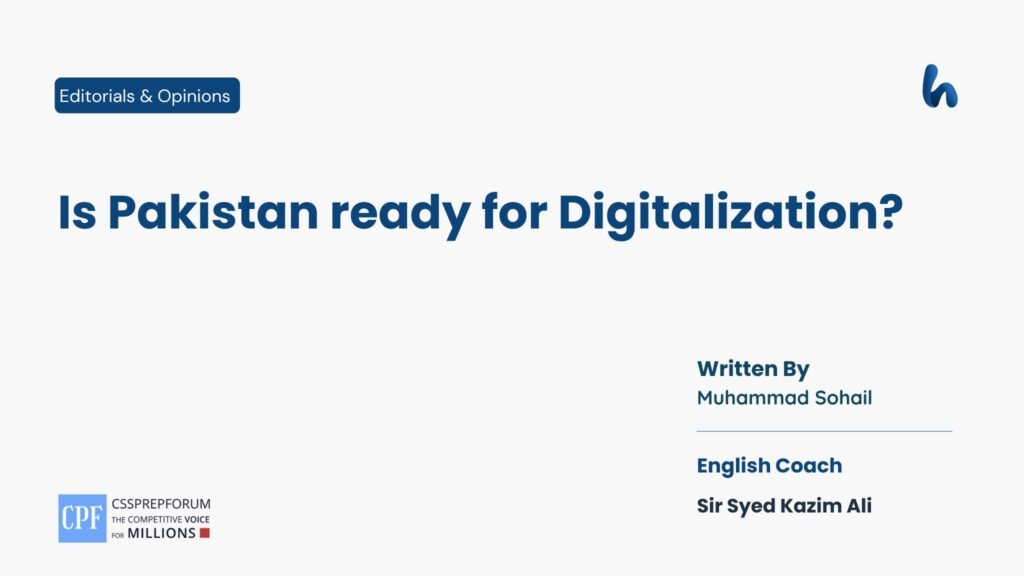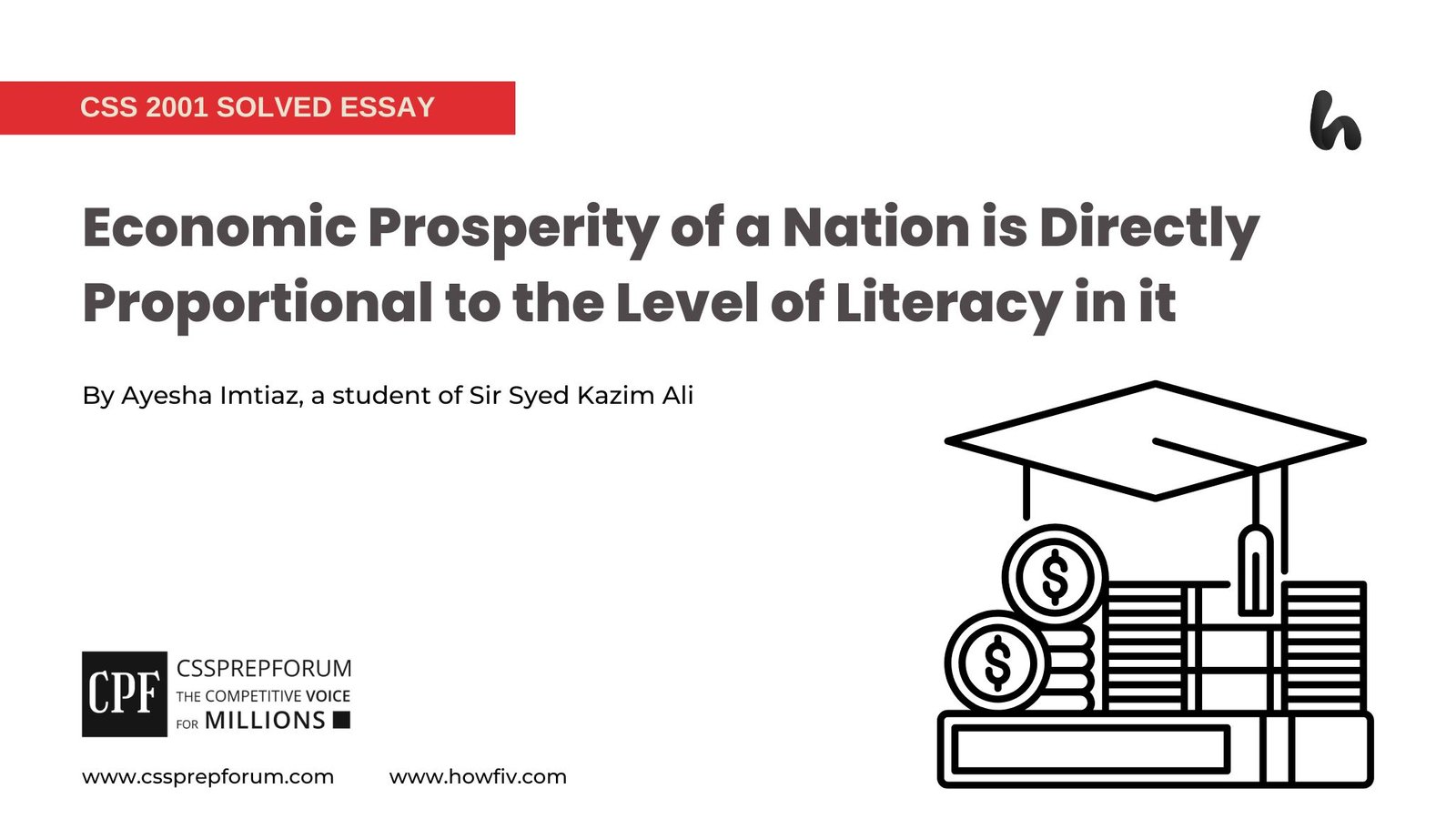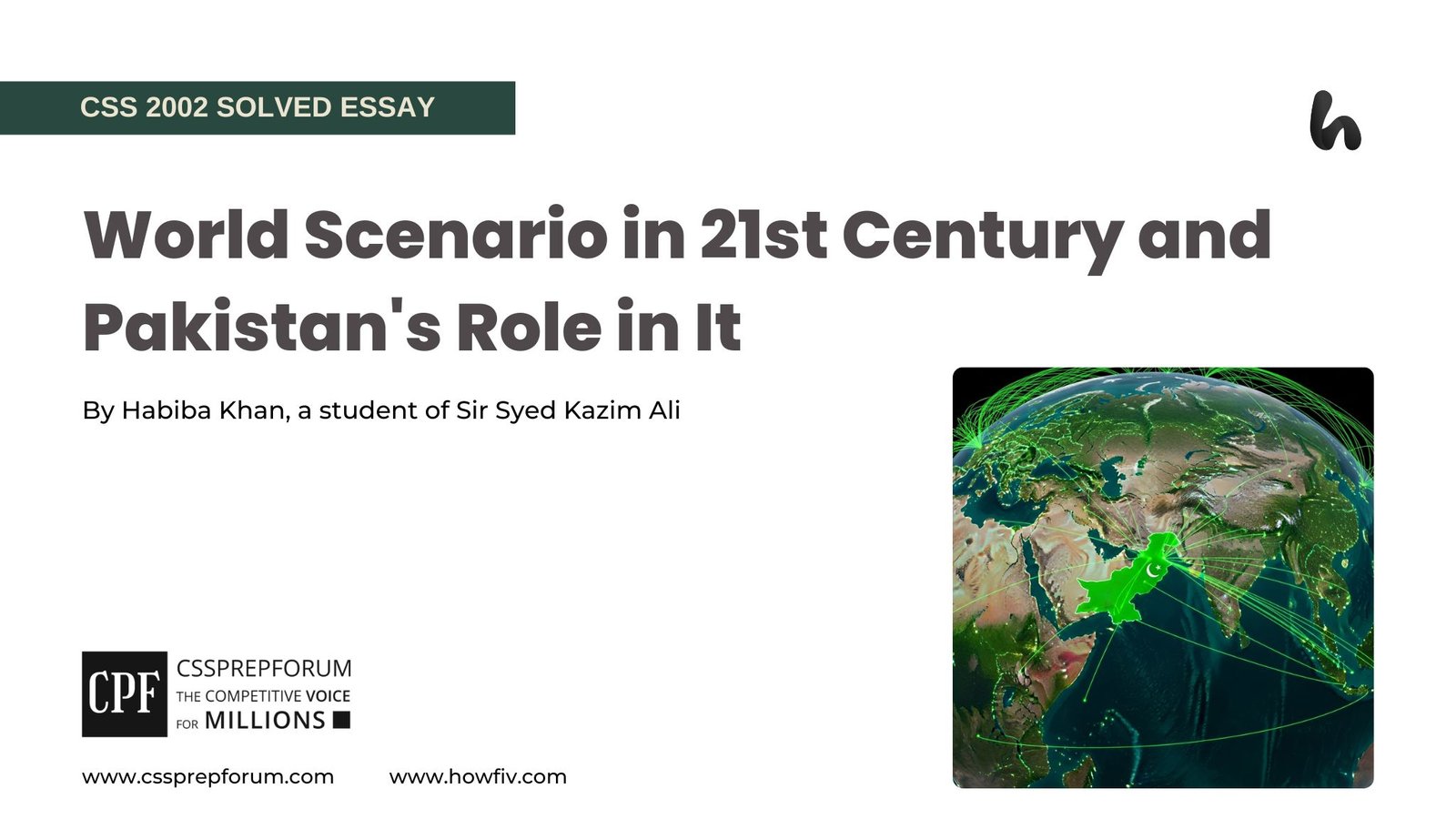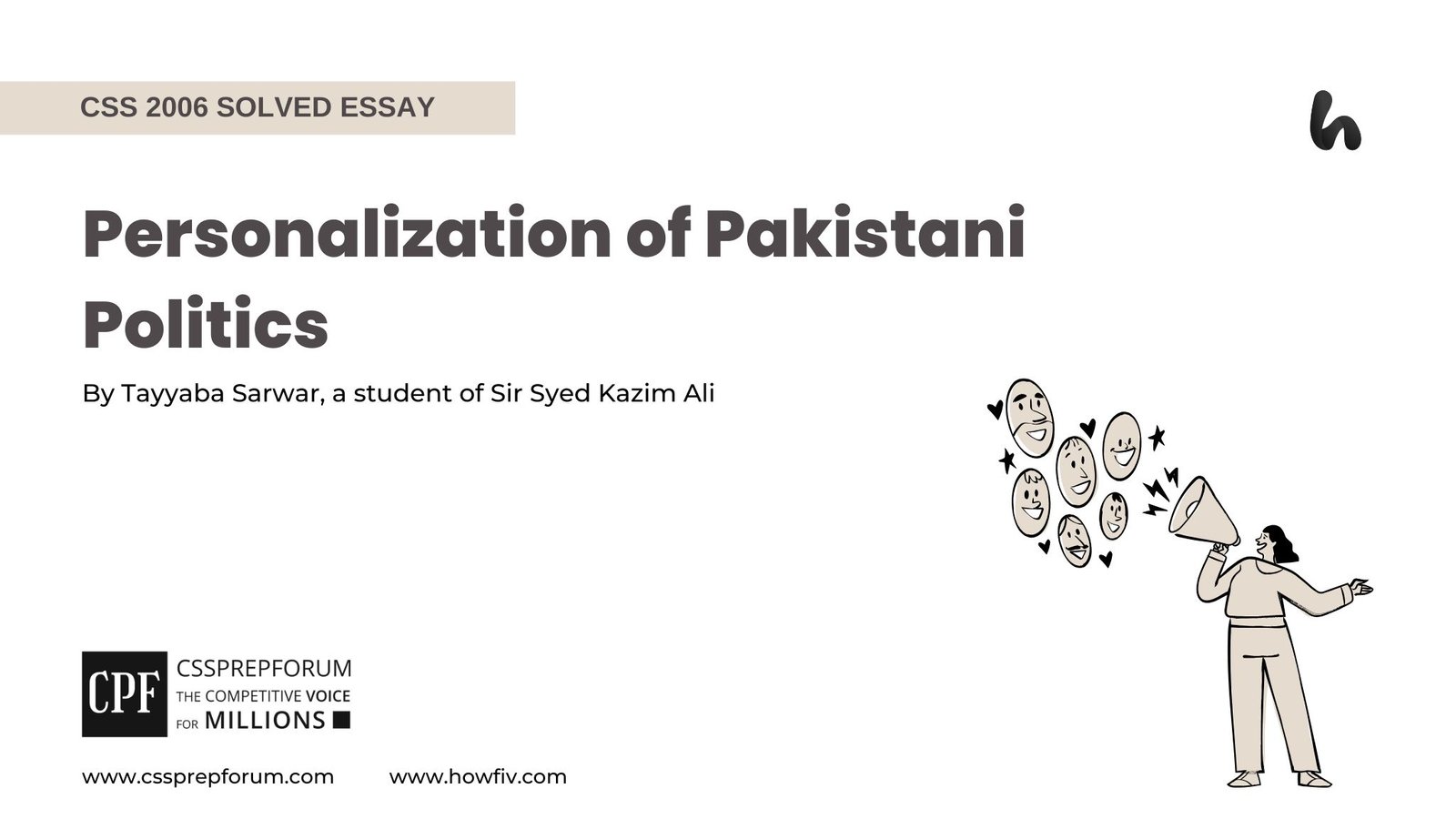Is Pakistan ready for Digitalization? | Editorials by CSS & PMS Aspirants
The following article, “Is Pakistan ready for Digitalization?“, is written by Muhammad Sohail, a student of Sir Syed Kazim Ali. Moreover, the article is written on the same pattern, taught by Sir to his students, scoring the highest marks in compulsory subjects for years. Sir Kazim has uploaded his students’ solved past paper questions so other thousands of aspirants can understand how to crack a topic or question, how to write relevantly, what coherence is, and how to include and connect ideas, opinions, and suggestions to score the maximum.

In the contemporary technologically advanced era, nations across the globe have raced to integrate digitalization into their economic, political, and social structures. Pakistan, too, finds itself at a crossroads where the promise of digital transformation is met with an equal measure of skepticism. On the one hand, the government’s ambitious policies, rising IT exports, and a burgeoning tech startup ecosystem signal a digital awakening. On the other, systemic challenges, such as digital illiteracy, infrastructure deficits, and economic disparities, thus raise concerns about the country’s true preparedness for a tech-driven future.

Stepping ahead, one must examine Pakistan’s progress and the hurdles hindering its digital evolution to assess its readiness for digitalization. This inquiry demands an exploration of the factors that indicate Pakistan’s preparedness for digitalization and the structural challenges that threaten to derail its technological ambitions.
Political Vision Laying the Foundation for a Digital Future
To start with, no nation can embark on a successful digital transformation without a clear political vision and commitment from its leadership. Considering this, successive governments in Pakistan have introduced policies to foster a robust digital infrastructure. For instance, the Digital Pakistan Vision, launched in 2019, set the stage for an integrated approach to IT development, e-governance, and digital literacy. Moreover, the National IT Policy emphasizes tax incentives for tech startups, foreign investment in IT, and the development of cybersecurity protocols.
In addition, e-governance initiatives have gained traction, with various governmental departments adopting digital solutions for documentation, record-keeping, and citizen services. For example, the Pakistan Citizen Portal has streamlined government-citizen interactions, significantly reducing bureaucratic inefficiencies. Similarly, the Pakistan Revenue Automation Pvt. Ltd. (PRAL) has digitized taxation systems, which increases transparency and reduces corruption. Therefore, despite these positive developments, policies alone are insufficient; execution remains a critical determinant of Pakistan’s success.
Educational Reforms and Technological Curriculum
Furthermore, a key determinant of digital readiness is the ability of a nation’s workforce to adapt to technological advancements. Recognizing this necessity, Pakistan has made significant efforts to modernize its educational curriculum by incorporating Artificial Intelligence (AI), Data Science, and Cybersecurity courses. Notably, universities, such as NUST, LUMS, and GIKI, have introduced specialized programs in these fields while the government has established tech incubation centers to support budding entrepreneurs.
Additionally, the introduction of IT training programs in schools and colleges signals a shift toward a more tech-savvy generation. For instance, DigiSkills.pk – an initiative by the Ministry of Information Technology – has trained over two million individuals in freelancing, coding, and digital marketing. As 64 per cent of Pakistan’s population is under 30, this young, tech-literate demographic can thus drive Pakistan’s digital evolution.
Internet and Broadband Expansion
Similarly, a robust digital infrastructure is the backbone of any successful digitalization effort. In recent years, Pakistan has taken significant steps to expand broadband access across urban and rural areas. To elaborate, the launch of PAKSAT MM1 – a satellite designed to improve internet connectivity – marks a major milestone. Furthermore, the Universal Service Fund (USF) has played a pivotal role in expanding 4G services to remote regions, reducing the urban-rural digital divide.
As a result, broadband penetration in Pakistan reached 46 per cent by 2022, with mobile subscriptions exceeding 187 million. In addition, mobile banking, a key indicator of digital adoption, saw an 8 per cent increase in users while internet banking grew by 5 per cent. Although these figures indicate progress, connectivity – therefore – remains inconsistent in several rural and underserved areas, limiting the full-scale benefits of digitalization.
IT Export Boom
Another crucial indicator of digital progress is Pakistan’s exponential rise in IT exports. To illustrate, Pakistan’s IT exports surged from $0.2 billion in 2013 to $2.1 billion in 2022. In fact, this remarkable growth is driven by government incentives, remote work opportunities, and the global demand for IT professionals. Moreover, freelancing has emerged as a key driver of this growth. Currently, Pakistan ranks as the fourth-largest provider of online freelancers globally, with thousands of professionals offering services in software development; graphic design; and digital marketing. Additionally, companies like Systems Limited, NetSol Technologies, and 10Pearls have established Pakistan as a viable player in the international IT market.
Besides, international tech giants such as Google, Amazon, and Microsoft have begun engaging with Pakistan’s digital economy, providing training programs; cloud computing services; and e-commerce opportunities. Therefore, with continued policy support and investment in human capital, Pakistan has the potential to become a regional technology hub.
The Rise of Startup Ecosystem
Parallel to IT exports, the startup ecosystem in Pakistan has witnessed rapid growth. Over the past five years, several homegrown startups have gained international recognition and attracted foreign investment. For illustration, Bykea – a ride-hailing and delivery service – has revolutionized urban mobility while Airlift raised over $85 million in funding before its closure due to economic instability.
Furthermore, Pakistan’s inclusion in Amazon’s seller program and the increasing presence of online marketplaces indicate a shift toward digital commerce. Platforms like Daraz and Telemart have expanded their reach, enabling thousands of small businesses to operate digitally. Hence, sustained support in funding, mentorship, and regulatory ease remains essential for continued Pakistan’s entrepreneurial success.
Digital Access Disparities
Despite these encouraging trends, concerns persist regarding Pakistan’s actual readiness for digitalization. One major obstacle is the country’s low ranking in global indices for internet accessibility and digital adoption. And the key reason behind this challenge is the urban-rural divide, where metropolitan areas enjoy high-speed internet while remote villages struggle with unreliable connectivity.
In addition, gender inequalities further restrict Pakistan’s digital access. According to a GSMA report, only 37 per cent of women in Pakistan have access to mobile internet, compared to 63 per cent of men. Hence, due to cultural and socio-economic constraints, women often face barriers to utilizing digital resources, limiting their participation in digital finance, e-commerce, and online education.
Skill Gap and Outdated Education System
Equally concerning is the persistent skill gap in Pakistan’s workforce. Although efforts have been made to introduce IT courses in universities, the outdated rote-learning education system hinders technological innovation. Moreover, the lack of STEM (Science, Technology, Engineering, and Mathematics) education at the primary and secondary levels further exacerbates this issue.
Consequently, employers frequently report difficulties finding skilled IT professionals, which forces many companies to outsource talent abroad. Thus, without comprehensive educational reforms, Pakistan’s workforce would always struggle to keep pace with global technological advancements.
A Digital Future in the Making, but with Caveats
In conclusion, Pakistan stands at the threshold of digital transformation, driven by ambitious government policies, rising IT exports, expanding broadband infrastructure, and an entrepreneurial boom. However, its path to full-scale digitalization is obstructed by glaring challenges – digital access disparities, workforce skill gaps, and infrastructural shortcomings. While the country’s digital potential is undeniable, achieving true digital readiness requires sustained investment in education, equitable internet access, and policy execution. Thus, the challenge is not about whether Pakistan is progressing toward digitalization but whether systemic barriers can be overcome to make digitalization an inclusive, sustainable reality.

CSS Solved Past Papers’ Essays
Looking for the last ten years of CSS and PMS Solved Essays and want to know how Sir Kazim’s students write and score the highest marks in the essays’ papers? Then, click on the CSS Solved Essays to start reading them.
CSS Solved Essays
CSS Solved General Science & Ability Past Papers
Want to read the last ten years’ General Science & Ability Solved Past Papers to learn how to attempt them and to score high? Let’s click on the link below to read them all freely. All past papers have been solved by Miss Iqra Ali & Dr Nishat Baloch, Pakistan’s top CSS GSA coach having the highest score of their students. General Science & Ability Solved Past Papers












